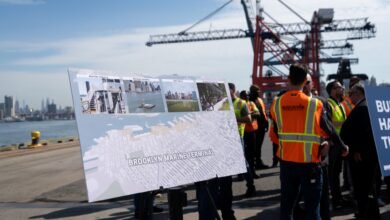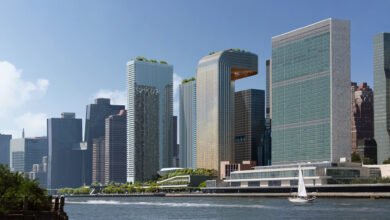Task Force Advances $3.5B Brooklyn Marine Terminal Overhaul

After multiple delays, a task force entrusted with the fate of the Brooklyn Marine Terminal has voted to allow plans to build thousands of units of housing on the site to move forward.
The task force, chaired by Rep. Dan Goldman, on Monday advanced in a 17-to-eight vote the $3.5 billion plan to redevelop the 122-acre marine terminal, which runs from Cobble Hill to Red Hook. The latest plan calls for 6,000 apartments on the site, with 40 percent set aside as affordable. Roughly half of the site will include modernized piers along with a new marginal pier for smaller and mid-sized ships.
The plan also includes 275,000 square feet of light industrial space, an up to 400-key hotel and 28 acres of open space.
Monday’s vote simply means that plans for the terminal will move forward, with the environmental review and the general project plan process coming next. But the task force had the ability to kill the project before it even began the state’s public review process — and its fate appeared precarious over the last few months.
The vote was postponed five times, as the task force struggled to get enough yes votes to move the project forward. The proposal has also undergone multiple revisions. Initial plans called for up to 12,000 housing units, which were then pared down to 7,700 and then to 6,000.
The critical vote was delayed amid accusations that the city and state were trying to rush the plan forward. Some elected officials, including Council member Alexa Avilés, a vice chair of the task force, and Brooklyn Borough President Antonio Reynoso, worried that the plan would further diminish the city’s industrial and manufacturing capabilities.
In a Brooklyn Eagle editorial she co-wrote with Eddie Bautista, Avilés, executive director of the NYC Environmental Justice Alliance and a member of the task force, called the plan “half-baked,” and raised doubts that the commitments made as part of the plan would be honored.
But last week, some of the task force’s naysayers were swayed by a number of changes, including an increase in funds for housing and industrial space. The Economic Development Corporation, the agency leading this project, has pledged to create a $75 million fund to build or preserve housing off-site within Community Board 6, up from the original $50 million commitment.
The administration also added 50,000 square feet of light industrial space, bringing the project’s total to 275,000 square feet, with a majority of that space dedicated to a single, mixed-use building planned for Pier 11.
Other new investments include $3 million for capital improvements at public schools in areas near the terminal and $7 million for improvements at DiMattina Park, Van Voorhees Playground, Carroll Park and other parks in the area.
This fall, EDC will also release a request for expressions of interest, seeking proposals for different port configurations and additional maritime industrial activities at the port. The agency will also develop an alternative for a larger port that will be analyzed in the environmental review process.
Last week, EDC credited Council member Shahana Hanif and Reynoso for helping to work out the changes, which ultimately paved the way for Monday’s vote.
The eight members who voted against advancing it were Council member Avilés; Carly Baker-Rice, executive director, Red Hook Business Alliance; Eddie Bautista, executive director, NYC-Environmental Justice Alliance; Ben Fuller-Googins, executive director, Carroll Gardens Association; Hank Guttman; Assembly member Marcela Mitaynes; Assembly member Jo Anne Simon; and Jim Tampakis, founder, Brooklyn Marine Spares International.
“We participated in the BMT Task Force in good faith, hoping that our engagement would shape a forward-thinking and equitable vision for our waterfront. Our goal from the beginning had been to get to a ‘yes,’ and we remained committed to that outcome,” the eight task force members wrote in a joint statement after the vote. “Unfortunately, to-date, many of our concerns with the EDC’s proposal for the site have gone unaddressed.”
An ailing piece of infrastructure
The city took control of the terminal last year through a land swap with the Port Authority of New York and New Jersey, which received Staten Island’s Howland Hook Marine Terminal in the exchange.
Much was at stake for the administration, which is trying to make good on a bet that creating a modern port — while also adding thousands of units of housing — was better than continuing to subsidize the activities of a flailing terminal.
During a tour of the site in June, EDC head Andrew Kimball described decades’ worth of deferred basic maintenance at the terminal, piling up to hundreds of millions of dollars. Two of the piers were condemned roughly a year ago, and another two are about eight to 10 years from collapsing, he said at the time.
The port handles roughly 60,000 containers every year, or roughly 1.5 percent of the containers brought into New York Harbor. The terminal has also been used for non-maritime purposes, storing mountains of aggregate, junk cars and decades-old modular hotel units.
Instead of replacing three of the long piers that jut out into the East River, the city wants to fill in the gaps between the aging piers to create a marginal pier deeper in the channel, allowing ships to sidle up sideways.
The administration saw the deal with the Port Authority as an opportunity to double down on moving goods by water — as a way to reduce trucks transporting perishable food items throughout the city, for instance — while also using a portion of the site for housing.
“You can’t just eliminate this site completely as a maritime opportunity,” Kimball said during the tour.
Pending approval by the state, developers of the residential sites will make payments in lieu of taxes, which will be invested into the terminal, rather than the city’s general fund. The Economic Development Corporation expects to fund the affordable housing component with revenues from the overall development and “additional public grants.” Officials have also pledged to invest $200 million in public housing complexes, Red Hook Houses East and Red Hook Houses West.
Kimball said that once the project is officially approved, a development corporation — whose members will be appointed by the governor, mayor and local representatives — will decide how to roll out the search for developers of the residential sites. He noted the “strong interest” among the task force members to ensure that multiple developers are involved, unlike the nearby megadevelopment Pacific Park.
The state is still in the process of approving new development teams for the remaining housing at that project, which has been criticized for not spreading the risk of developing those sites among more developers.
Read more

City once again kicks can on Brooklyn Marine Terminal vote

The Daily Dirt: Red Hook Terminal vote kept at bay

City nabs control of Red Hook waterfront, plans redevelopment




